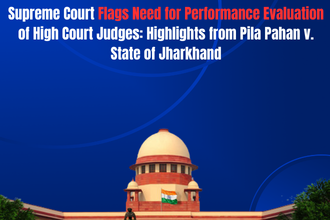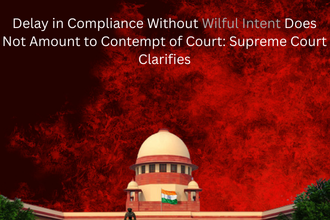The Supreme Court of India, in a significant observation on September 22, 2025, stressed the urgent need for performance evaluation of High Court judges. The Court underlined that while some judges consistently work with diligence and dispose of matters expeditiously, others fail to meet the expectations of litigants and the justice delivery system.
This observation came during the hearing of Pila Pahan @ Peela Pahan and Ors. v. State of Jharkhand and Anr., a case that exposed delays in the pronouncement of judgments by the Jharkhand High Court.
The ruling is not just case-specific but raises larger concerns about judicial accountability, efficiency, and the credibility of the Indian judiciary.
Background of the Case
The plea was filed by four life convicts belonging to Scheduled Tribe (ST) and Other Backward Classes (OBC) communities. They alleged that the Jharkhand High Court had failed to pronounce verdicts on their criminal appeals even after reserving the cases for two to three years.
The matter eventually reached the Supreme Court, which in May 2025 directed the High Court to act on the appeals. Following the apex court’s intervention, the Jharkhand High Court finally delivered rulings in all four appeals, which had been pending for nearly three years.
However, the Supreme Court took note of the broader issue: the delay in pronouncing reserved judgments, a problem that is not confined to one High Court but affects the judicial system nationwide.
Supreme Court’s Key Observations
A Bench of Justice Surya Kant and Justice NK Singh made several crucial points during the hearing:
1. Performance Evaluation of Judges
The Court suggested evolving a performance evaluation mechanism for High Court judges. It stressed that while many judges work tirelessly, some fail to deliver judgments with the same efficiency.
“Another thing we may suggest is the performance evaluation of judges. That is also a very big challenge… Our intention is not to act as a school principal and monitor everything, but there should be broad guidelines. Judges should know what the task before them is. This is the legitimate expectation of the public at large,” the Bench observed.
2. Dangers of Routine Adjournments
The Court criticized the routine practice of granting adjournments, noting that it damages the credibility of the judiciary and discourages litigants who seek timely justice.
If judges gain a reputation for routinely granting adjournments, the Bench warned, it sends a “demoralising message” to litigants and undermines faith in the justice system.
3. Self-Management for Judges
The Court emphasized that judges must adopt a self-management mechanism to ensure they are efficient in disposing of cases. Instead of piling up matters, judges must focus on timely disposal without compromising the quality of judgments.
4. Standardisation of Court Data
The Amicus Curiae, Fauzia Shakil, presented a tabular chart with information received from High Courts regarding pending reserved judgments. However, she pointed out that the data was not presented in a uniform format.
In response, the Court suggested standardising formats so that every uploaded judgment contains three key dates:
- The date on which the case was reserved,
- The date on which it was pronounced, and
- The date on which it was uploaded.
5. Uploading of Reasons with Judgments
The Court reiterated its earlier ruling in Ratilal Jhaverbhai Parmar v. State of Gujarat, where it was held that reasons for a judgment must follow promptly if only the operative part is pronounced.
The Court directed High Courts to upload reasons within five days of pronouncement. It allowed limited flexibility by stating that the timeline could be extended to 10–15 days in exceptional cases.
Broader Implications of the Judgment
The Supreme Court’s observations in Pila Pahan v. State of Jharkhand are far-reaching. They touch upon three important aspects of the judiciary:
1. Judicial Accountability
For long, judges in India have enjoyed absolute independence without a performance review system. While independence is crucial, the Court has now made it clear that judicial accountability cannot be compromised. Performance evaluation may soon become part of judicial reforms.
2. Delay in Reserved Judgments
The issue of delayed reserved judgments is widespread. Litigants often wait months or even years for judgments after arguments are concluded. The Court’s directive to create uniform rules and fix timelines is expected to reduce this problem.
3. Public Confidence in Judiciary
By addressing inefficiencies, the Supreme Court is also trying to restore public faith in the justice delivery system. A judiciary that delivers timely and reasoned judgments strengthens democracy and the rule of law.
Challenges in Implementing Performance Evaluation
While the Supreme Court’s observations are timely, implementing them may not be easy. Some potential challenges include:
- Balancing Judicial Independence and Accountability: Performance evaluation must not undermine the independence of judges or create undue pressure.
- Objective Parameters: Clear, measurable criteria need to be developed for evaluating judicial performance. These could include timely disposal, quality of judgments, and adherence to procedural fairness.
- Institutional Resistance: The judiciary may resist external evaluation, preferring self-regulation instead.
- Administrative Burden: Collecting and publishing uniform data across all High Courts will require technological and administrative reforms.
Way Forward
The Supreme Court has listed the matter for further consideration on November 10, 2025, signaling that this issue will continue to evolve. Going forward, reforms could include:
- Adoption of broad guidelines for performance evaluation, without micromanaging judges.
- Technology-driven solutions to track case disposal rates, adjournments, and pending reserved judgments.
- Periodic publication of judicial performance reports to ensure transparency.
- Capacity-building measures such as training, mentoring, and workload balancing for judges.
Conclusion
The Supreme Court’s remarks in Pila Pahan v. State of Jharkhand mark a turning point in the debate on judicial reforms in India. By calling for performance evaluation of High Court judges, strict timelines for reserved judgments, and a crackdown on routine adjournments, the Court has highlighted the urgent need for efficiency and accountability.
As India’s courts continue to grapple with backlogs and delays, the introduction of performance evaluation may become a key step toward ensuring timely justice and strengthening public trust in the judiciary.
The coming months will reveal how far the judiciary is willing to go in adopting these reforms, but one thing is clear: judicial accountability is now at the forefront of India’s legal discourse.
Also Read



